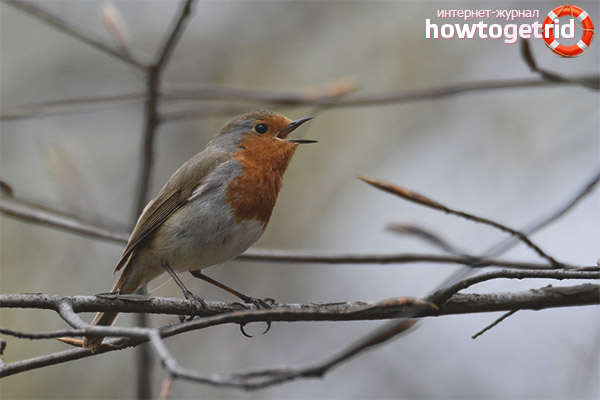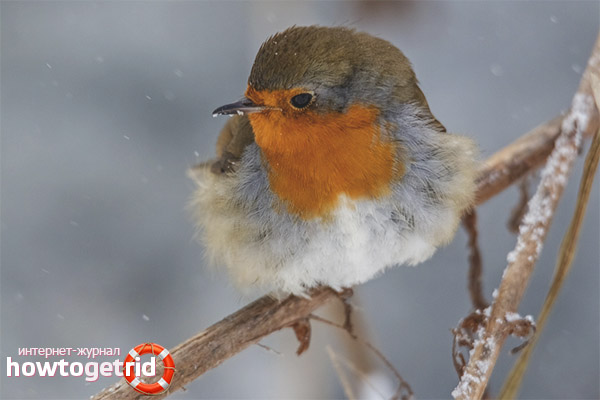The content of the article
Zaryanka is also called a robin, this songbird does not differ in overall characteristics. It belongs to the flycatcher family, respectively, the main part of the diet is winged insects. For many years, birds are considered the most popular inhabitants of Europe. They are loved for the singing and the benefits that individuals bring to others. But we will not run ahead, we will study the most important features in order.
View Features
- It has long been believed that birds are guardians of customs and sacraments. People believed that if individuals settled near the dwelling, then the whole family would be happy.
- If you follow the beliefs, small feathered individuals protected the house from negative energy and took aside all adversity. If someone broke the nests, they were punished on all counts.
- Usually, farm workers were involved in digging up land with birds of this species. Since individuals are not afraid of humans, they calmly waited for the completion of work, and then feasted on worms and insect larvae.
Description
- Initially, the discussed individuals were considered to be a thrush, but soon the classification was revised, the birds began to be classified as passerine. It has already been mentioned that they are part of the flycatcher family.
- Individuals of female and male affiliation are partially similar to each other. Both sexes have plumage of an orange tone in the chest area. There is also a bordering in the beak and brisket. The abdominal part is covered with whitish feathers with dots of brown tone.
- The hue of the back is brown with a gray tint. As for the size, these birds can grow up to 14 cm. Along the length of the hull. The paws are brownish, the eyes are black, as are the beak. Since the eye sockets themselves are large, birds easily navigate in space among the vegetation.
- Representatives of the detachment who have not reached puberty are not so saturated. In their plumage, brown pigment with white dots predominates. Only over time does an orange or red area appear on the brisket.
- It makes sense to consider and disseminate. Birds live in northern Africa, in the west and east of Siberia, in all European countries. Individuals living in the cold are sent to warm places for wintering every year. But the birds from the southern climatic zones remain in their places.
Lifestyle
- Often these birds are confused with representatives of nightingales, because they begin to sing in the spring. However, unlike nightingales, in our case a beautiful trill can be heard not only from representatives of male gender.
- Birds compose and pose their songs at night, so people can clearly hear all the notes. While nature is sleeping, zaryanki compose notes and delight young people passing by. They are not at all afraid of people, noisy places and parties.
- With their beautiful singing, males denote territorial property and do not allow anyone to occupy it. Females announce readiness or not preparedness for mating and further family building. Birds transmit voice messages to each other, after which couples form.
- If in the summer time the songs look loud, then in the winter they seem dull. Females go to neighboring regions where there is more food. But individuals of masculine affiliation do not leave the occupied possessions and protect them until the end.
- It is interesting to know that by the natural number of males there are more than females. As a rule, it is for this reason that some members of the family are left without a companion. Bachelors do not guard their possessions as much as family birds do.
- Birds are most active at night, the main thing is that the moon shines brightly or there are lanterns nearby. The fact is known that individuals are not afraid of people, can fly close and even feed by hand. But this is not observed in all countries, in some areas they are being disposed of for unknown reasons.
- Male representatives are quite aggressive when defending territory. They can attack their relatives. Many cases of aggression have been recorded, due to which more than 10% of the deaths of other birds occurred due to the fault of male zaryanok.
- If you are interested in the question regarding life expectancy, then let’s clarify that birds hardly live up to a year. This is a question of existence in the natural environment. As for home maintenance, robins can quite live up to 5 years or more. The main thing is to provide them with proper care.
Habitat
- The range of individuals is quite extensive. Birds are found from Eurasia to Western Siberia. Also, their habitats stretch to the south of Algeria. In addition, birds are common on islands that are located in the Atlantic Ocean. The considered individuals are not found only in Iceland.
- In addition, their habitat extends to the southeast of the Caucasus Range. Individuals who live in the aisles of England, try to stay for the winter in their native lands. Only a small fraction of the females often migrate to Spain and southern Europe. Zaryanka, who live in Russia and Scandinavia, winter in Western Europe and England.
- Thus, the birds try to escape from the harsh winters, which are characteristic of habitual habitats. Often individuals prefer to build nests in spruce forests, the British Isles and Northern Europe. Sometimes such forests intertwine with gardens and parks.
- In the 19th century, they tried to get such birds in New Zealand and Australia, unfortunately, the attempts were unsuccessful. The birds were released in Dunedin, Auckland, Wellington, Melbourne and Christchurch. It is worth noting that, on such lands, individuals still did not take root.
Food
- Often, the main diet of such birds includes all kinds of insects and invertebrates. In addition, such individuals often feast on berries, earthworms and fruits. However, it is worth noting that birds feed on such food exclusively in the warm season.
- As for invertebrate living creatures, birds often find them on the ground. They often bite even snails. The birds are not even a hindrance to their small size. From the outside it may seem that the zaryanki are pot-bellied and rounded. This visual effect is created due to the special plumage.
- As soon as the cold comes, individuals go in search of food of plant origin. During this period, the birds try to eat almost all the seeds that fall in their way. Feathered even often fly to the feeders to feast on bread crumbs and grains.
- In addition, in the cold season, Zaryanka live near non-freezing reservoirs. In shallow water, such individuals can enjoy various animals without problems. Birds do not feel any fear of water. Zaryanka does not feel fear of a person. Therefore, they can take advantage of the work of people.
- Among other things, such birds in the forests accompany wild animals that constantly drip the ground. It can be wild pigs and bears. Often youngsters take such youngsters with them on such trips. As a result, the birds can get their own food and feed the chicks, who are learning at the same time.
Breeding
- During the nesting season, the presented individuals breed two offspring in a row. This occurs in spring and summer. Such birds are endowed with an excellent parental instinct. It happens that the first brood may be lost. In this case, the eggplants begin the second clutch in mid-summer.
- In addition, during the mating season, it is very interesting to observe the behavior of individuals.Their mating season is very different from most birds. The fact is that during nesting the female begins to show initiative. She flies into his territory and begins to sing. The female still spreads her wings wide.
- In this case, the male can be aggressive, as he tries to protect his own territory. It makes frightening characteristic sounds. The female yields and flies to a neighboring tree. Courts last several days.
Due to the characteristic features of the zaryanka, they are not similar to any of the birds. They are unique in nature and very interesting. The diet of birds is almost banal. Birds very closely monitor their offspring and constantly guard, educate it.
Video: zaryanyka (Erithacus rubecula)












Submit